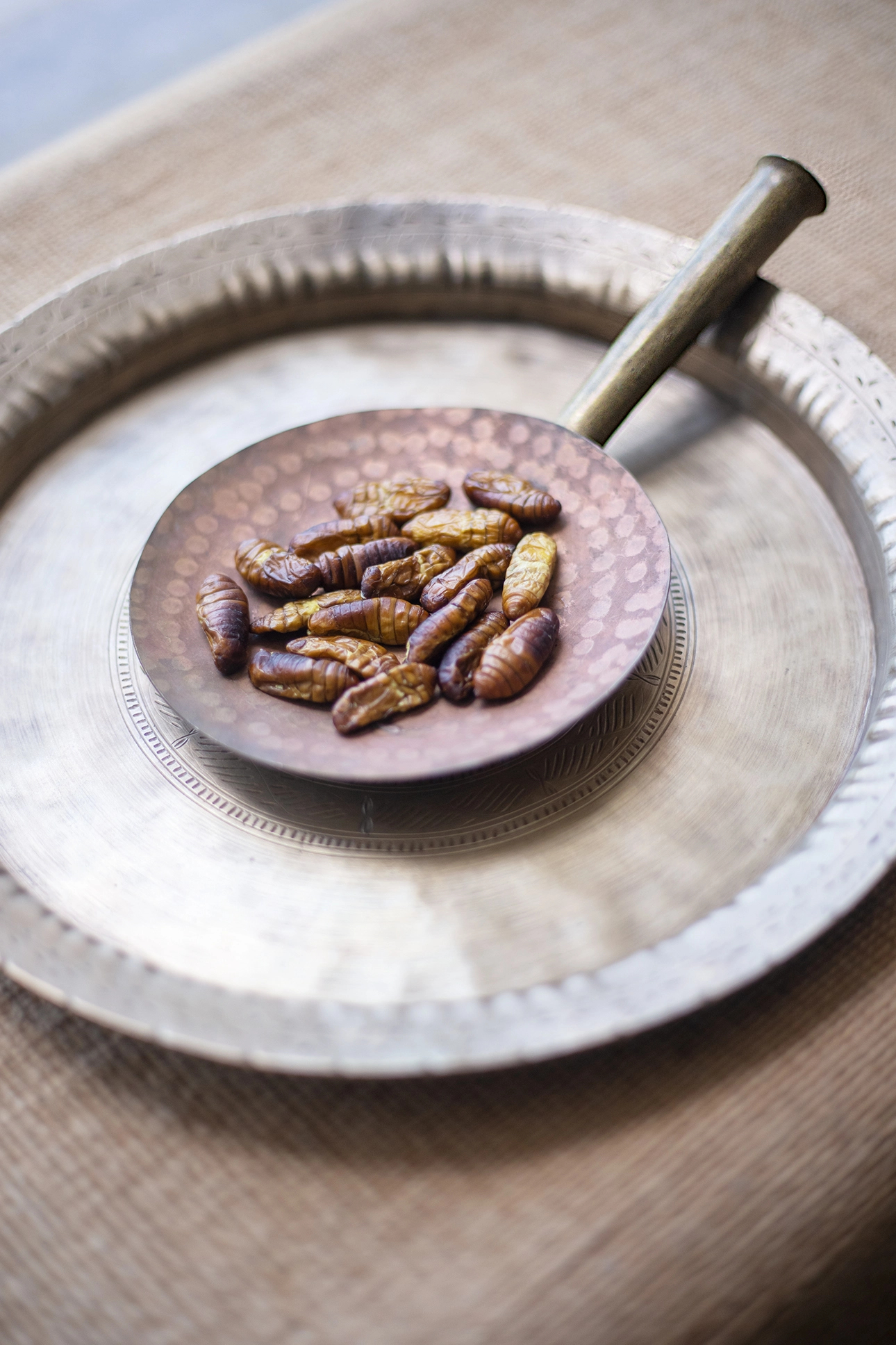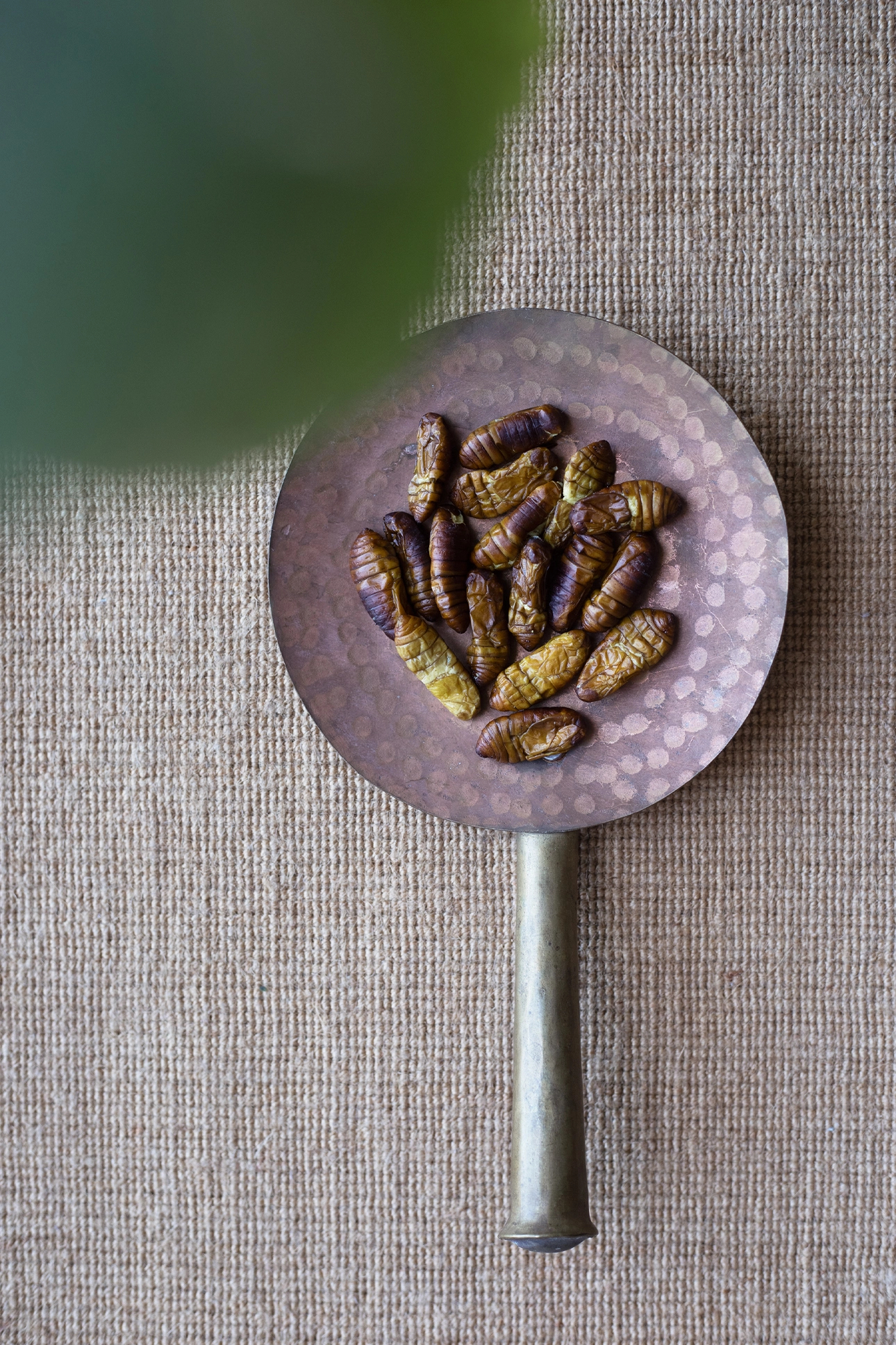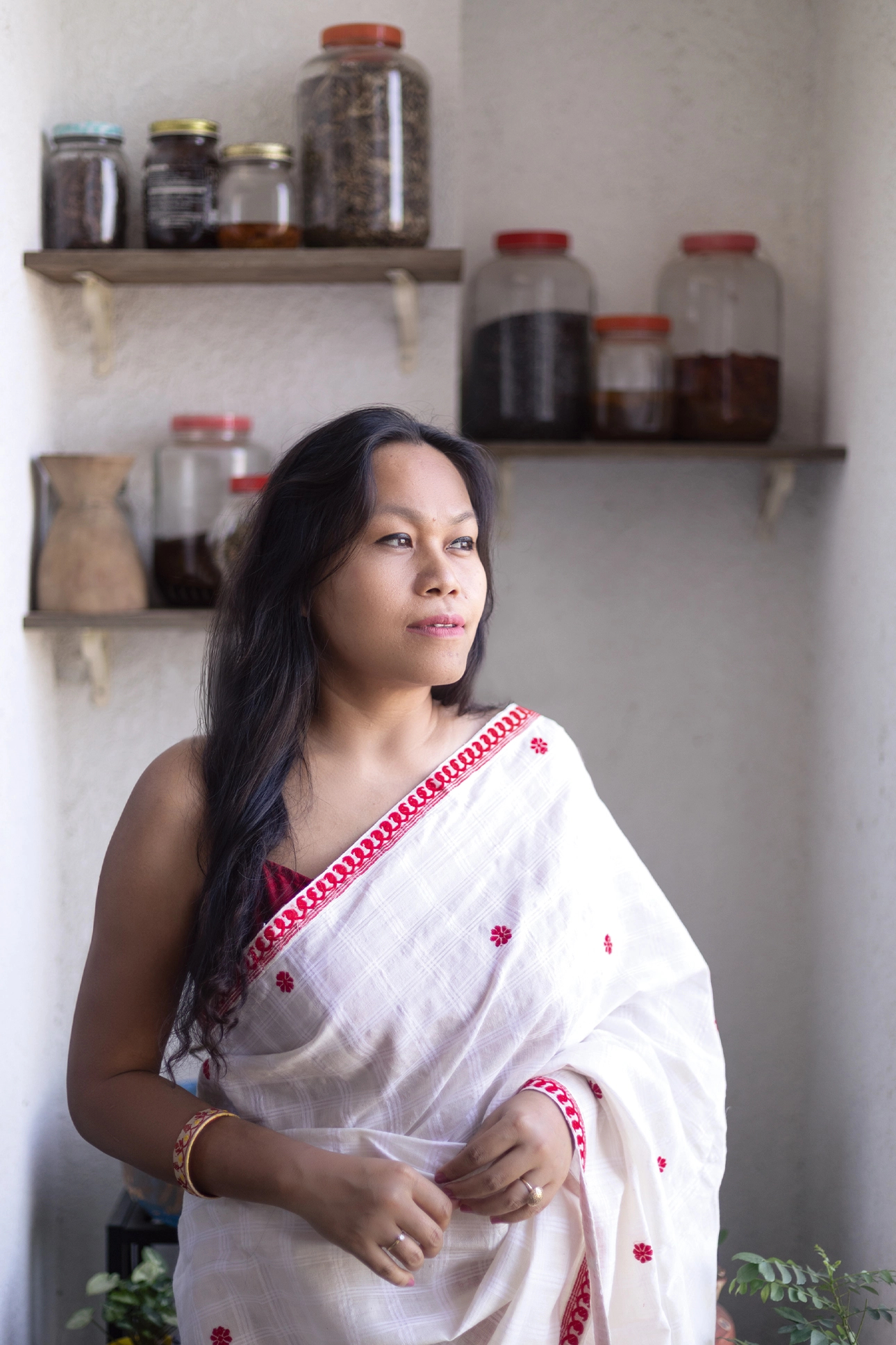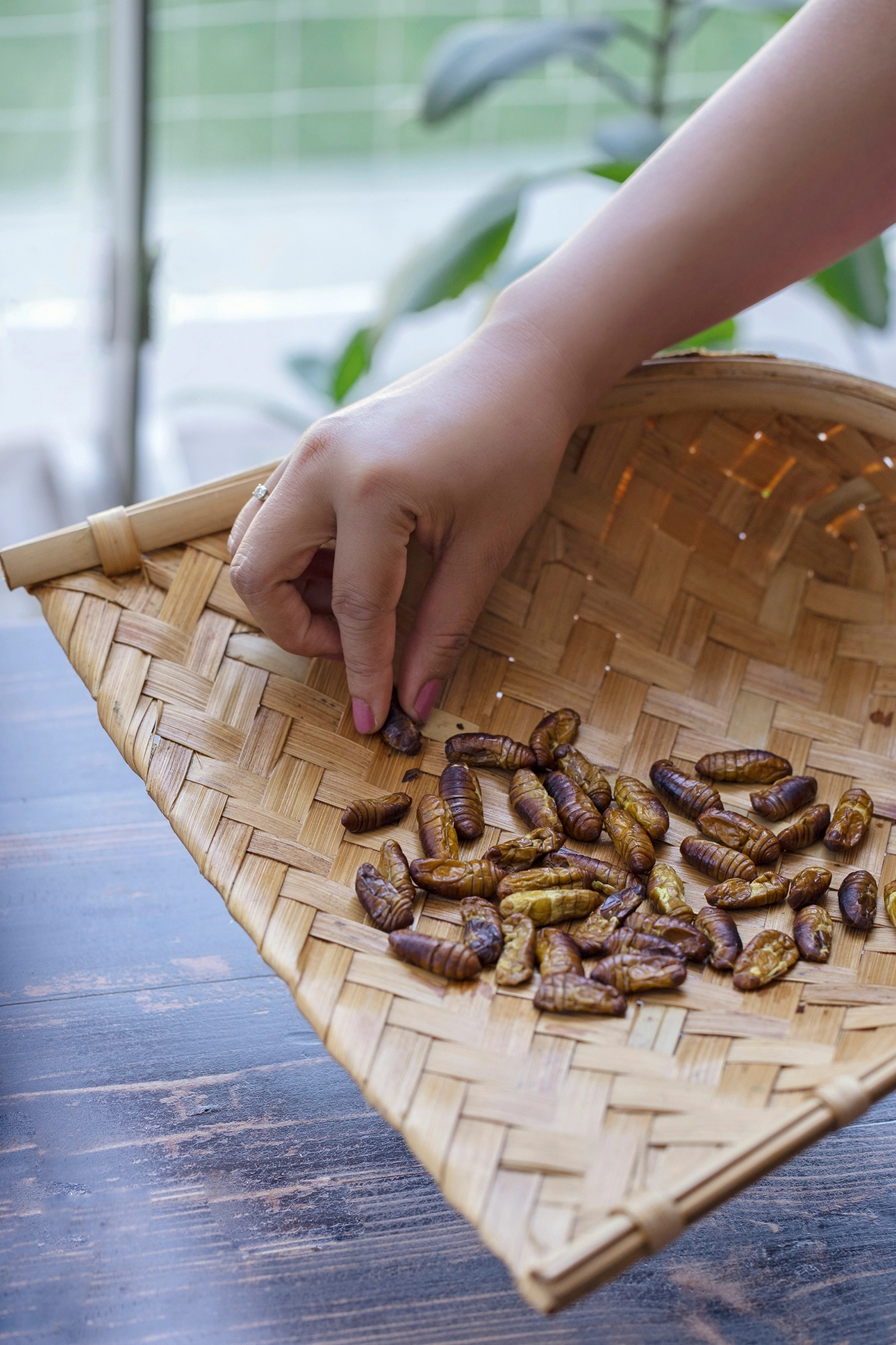
In my life, I have probably eaten a cockroach or two. But never knowingly. However, a few close encounters of the creepy-crawly kind, have led to a somewhat perverse interest in insects as food. I do not picture myself sitting down to a pile of bugs on my plate, though, yes, I am forever open to extending my repertoire of tastes. So, who knows what I might, quite knowingly, ingest next!
I became aware that many parts of the world consume insects in quite a matter-of-fact way, on a trip to Bangkok, several years ago. Wandering around one of the city’s food markets, hopeful about tasting some of its famous street food, I stumbled upon carts covered in heaps of crispy, crunchy looking snacks. Excited at discovering something novel, I pushed through the crowd of locals, only to be met with a sight that I will never forget — mounds of fried or roasted grasshoppers, bees, crickets — spindly legs poking out everywhere, charred wings, bulging eyes…. I turned away then from that bug stall, looking for some familiar pad thai instead. This, my first brush with an insect-eating population, had left me somewhat shaken! But South-East Asia is where the edible insect market continues to grow quite exponentially.
Since then, I have cheerfully munched my way through every animal body part worth mentioning, including the brain, trotters, tripe, ears, cheeks and even pig’s tail and snout one cold midnight in Paris. But never an insect. Until a couple of years ago, at the prestigious Copenhagen restaurant Noma, where award-winning chef-owner René Redzepi, as part of his reindeer feast, dished up a delectable sauce stippled with wild ants. Was it the reindeer heart carpaccio that I dipped into this, the ants bursting in my mouth with the sharp acidity of citrus and lemon? (Ants produce formic acid as a defence mechanism, which gives them acidity.) Later, on a back-end tour of the restaurant, one of the chefs explained the wild gathering of the ants on large white sheets spread out under forest trees, their natural environment. An “aquarium” mimicking this insect habitat, in one of the back rooms, revealed the restaurant’s interest in breeding these scurrying black creatures while the greenhouse-like, glass-walled structures in the restaurant garden proved to be R&D labs, food laboratories that studied the efficacy and deliciousness of foods of the Nordic region, including the gastronomic wonders of the wood ant, grasshopper and bee. Redzepi is one of a group of gastronomic leaders intent on developing a broader culinary context for insects, slowly chipping away at the disgust that non-insect-eating, mainly Western, populations tend to feel for them. Flecking a sauce, almost no more than a seasoning, left me the option of trying the ants or not, and I decided at that moment of getting into the dish, to take that plunge. Quite knowingly!
Ever since the UN published its rallying cry in 2013 in its favour, entomophagy or the practice of consuming insects by humans, has become a topic of rising interest. Insects are being seen as an alternative protein-rich food capable of replacing conventional meat and mitigating the devastating effects of rearing livestock. Silkworms, ants, grasshoppers, bees, locusts among others, have been discovered to be a good source of dietary fibre, healthy fats, vitamins and essential minerals; eating them is nutritious and good for you. The ingestion of insects is being seen as a solution to the problems of global hunger as well as widespread resource degradation. These minuscule creatures require little food and space to breed, thus providing a certain democracy where even the poorest can realise their production.
Entomophagy has a strong tradition in several parts of the world, and, for millions of people, insects are already an intrinsic part of their culinary cultures. A trip to Mexico, last year, threw up bags of chapulines or grasshoppers, doused in chilli powder and pepper being sold at street corners in cities like Oaxaca. While I could not bring myself to ingest these, I did allow some to be ground into a particular salsa that embellished our tacos at a local restaurant. What the eye does not see, the stomach will not shudder at, I figured! Later, visiting some of Mexico City’s most acclaimed restaurants introduced me to some more bugs, most notably the popular escamoles, the edible larvae and pupae of ants (pupa is a phase in the life cycle of an insect), a delicacy of the area. A delectable chicatana ant mayonnaise, for instance, gave insect gastronomy a whole new meaning, in my mind. In a feature on Mexican restaurants (Verve, October-November 2019) we asked three Mexican chefs who have gained international standing due to their very forward food philosophies, what they considered the ingredient of the future. And with two of them, the answer was, “Insects!”.
Closer home, in India, it is North-Eastern cuisine that notoriously features several of these tiny creatures as part of their traditional food culture. Eri polu silkworms, from which the popular eri thread is acquired, are used in the preparation of a local delicacy, while chaprah is a chutney made of red ants. Here, silk-moth pupae are eaten after they have been boiled for extracting silk — either directly with salt or fried with ginger-garlic and chilli as a snack or dish. We speak to home-cook Gitika Saikia who refers to herself as an “Assamese food evangelist” and, through Gitika’s PakGhor, showcases Assamese tribal food for Mumbai’s adventurous food buffs, in city pop-ups. Saikia gave up a well-paid job as a marketing professional to follow this passion. The young mother of a three-year-old, however, bemoans the difficulty she faces in sourcing these traditionally-consumed ingredients, inserting a caveat to the euphoria of insect-savouring and their supposed sustainability benefits. “Assam’s weaving communities hardly weave anymore,” she regrets, thus endangering the domesticated eri polu. And as for the water beetle, she contends that they are almost extinct. “At one time there was an excess of these insects in village ponds. But today, if you catch 20 kilos of fish, you may find five or six beetles.” As difficult to procure are the red ant eggs, ferreted out principally from mango trees. “These are impossible to rear, and so we do not eat them throughout the year,” she explains. “The eggs are laid in mid-March, and we eat them only until around April 20th. We eat only a part of the eggs, for, if we had them all, there would be no more ants left for the next season.”
As for me, after my chat with Saikia, I may just be more open to chew on a grasshopper, ant or bee, poky legs and all….

Did you eat silkworm pupae as a child? Are these dishes in any way linked with the culture of the region?
Yes, I remember eating silkworms when I was probably five or six years old. We lived in Namrup, a sleepy industrial town in the Dibrugarh district of Upper Assam. Thankfully, our dad’s ancestral home in Nigam Gaon was just a few kilometres away by road. When we were young, we used to regularly visit during holidays, festivals and social functions, to meet our cousins. During one of those visits, I came across silkworm pupae being served with rohi, the first concentrated press of rice beer.
If you ask about its popularity, the eri polu silkworm was commonly served during festivals Bohag/Rongali Bihu (in April) rather than the other varieties like muga and paat silk polu (muga polu gives us muga silk, and paat polu gives us paat silk threads). Silkworms are widely eaten, but one has to have access to weavers or people who rear them at home for personal consumption. Also, the availability of silkworm pupae is greater during the warmer months rather than in winters because the worm doesn’t weave cocoons in colder months (and winter is quite prominent here). The consumption of pupae is common amongst the Sonowal Kachari or Upper Assam Tribes and other ethnic communities, whereas in Central Assam, I have come across the Bodos, eating it in the worm phase. Personally, I have eaten only the pupae.
In Upper Assam, the silkworm pupae are mostly stir-fried with salt, turmeric, green chillies and crushed garlic and best served with rice beer (Mod or haaj), the best combination that one can be offered as a guest. And, if you are lucky, you might be served a portion of red ant eggs scramble with duck eggs (only during Bohag or Rongali Bihu). Whereas in my in-laws’ house in Tezpur (Central Assam), it is cooked in a chutney form or khar, an alkaline curry using silkworm, garlic, tomatoes and kol khar (an organic alkali produced from banana peel), of course!
The frequency of consumption totally depended on whether you lived in a village or urban areas or had access to a village haat (market). These insects or worms are a part of tribal culture as the tribes were almost the last ones to convert into an agrarian community. They were primarily huntsmen, believing in eating everything that Mother Nature provided them with. It was not every day that they were lucky enough to be able to hunt a big animal. And, even if they did so, they would have to smoke the meat or fish…that’s how the smoking of meats or fermented foods came into being much earlier, as a necessity in their lives (in the absence of a refrigerator) and the concept of eating fermented food is becoming mainstream now. Plus eating insects is highly accepted amongst the tribal and ethnic communities.

How do silkworm pupae taste? What’s the mouthfeel?
Since the time that I’ve served these in my pop-ups from way back in 2015, people have had different opinions of its taste and texture. Personally, I feel it is nuttier but softer and tastes like a jackfruit seed, weaving a ring of prawn-y aftertaste.
Where do you source insects from for your business? Did you forage for silkworms and insects as a child?
My stash is flown down from Assam whenever there is a pop-up. As a child, whenever I visited my relatives in the village or my paternal ancestral village home, I witnessed eri silkworms being fed mulberry leaves (or nuni paat as they are known in our local language). In those days, I was reluctant to try these “creepy crawlies” and ran away from them. I used to wonder why people reared them and what purpose they served. I would only eat the pupae but stayed away from the worms. Silkworms are still bred, as silk thread is extracted from the cocoons. These are mostly sold in weekly village markets by farmers. Whereas red ant eggs, another delicacy, are found on trees; they can’t be reared and are available for a brief period only. For red ant eggs, I forage in the wild in our farms because they build their nests or lay eggs in mango or Indian olive trees. As for the water beetles, they are found in ponds only, and we need to have our own ponds to get a handful of them.
What is the variety of silkworm that is consumed here? Are they cultivated or are they the by-product of sericulture?
We mostly consume the eri polu silkworm or eri polu pupae. These are cultivated either for personal consumption by villagers or by weavers for silk thread. The weavers will have a more constant supply as they do it for a commercial purpose. When we buy from weavers, the cocoons are always returned to them to extract the silk thread after the pupae are removed.

What made you leave your corporate job and take up cooking?
The sole reason to leave my 12-year corporate career behind was to “create an identity for the North-East cuisine”. People mistakenly identify us as only momo-eaters, that we eat only non-vegetarian food and everything that crawls, and that our cuisine is similar to Bengali food. Mainland Assamese cuisine is only somewhat similar to the cuisines of West Bengal, Bihar and Odisha.
How did you learn to create the traditional dishes of the North-East? Where do your recipes come from?
The sources of my recipes are varied — inspired by various tribes like the Sonowal and Bodos as well as extensive research done on every visit to the North-East, and even some learnt from my hostel mates. Every time I go home, I make it a point to visit a new tribal family from the village, cook with them and make minor changes, if needed, for my pop-ups here.
Do you see the consumption of insects as a solution to world hunger?
Well, it is too early to say that. Because, first, the taboo associated with eating insects has to be tackled, and I think there is still a long way to go, in India at least. Though a lot of research and work is being conducted to introduce these proteins, people will first have to be educated thoroughly. I remember, when I first started my home dining experience, there were hardly any takers for this “bland” cuisine. Similarly, this topic needs awareness build-up and education for wider acceptance.
You said that this ingredient is becoming rare. Why is this so?
The ones becoming rare are the red ant eggs, water beetles and crickets, and this is thanks to urbanisation, which includes the uprooting of trees and the younger generation moving to cities for jobs. In terms of water beetles and crickets, availability is a major concern, thanks to environmental changes resulting in reduced production, as also due to a lower interest amongst the younger generation to preserve this culture.

Are there any environmental reasons that silkworms and insects were and are eaten in the North-East?
As mentioned earlier, the tribes were originally hunter-gatherers who consume whatever nature has to offer. Not only these, the variety of wild leafy greens and edible flowers consumed in the North-East is proof of this fact.
If eating insects became the norm, how would it affect the environment?
While we want to popularise insect consumption amongst people, it is equally important to first study and adopt practices on how to increase production and not allow them to go totally extinct from the universe. A few of them are already on their way, so it is imperative to even educate the farmers on how to protect them from going extinct, increase production, and maintain a healthy balance of demand and supply.
Cooking Silkworms
Polu Leta Fry
Ingredients
Silkworm pupae, 1 cup;
Garlic pods crushed, 2-3;
Green chillies, as required;
Salt and turmeric powder, to taste;
Mustard oil for cooking.
Method
Heat oil and sauté crushed garlic. Add salt and turmeric followed by silkworm pupae. Sauté for five minutes and the dish is ready.